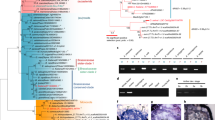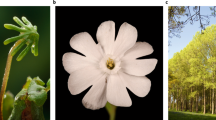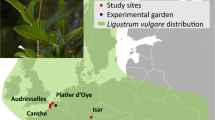Abstract
THE population dynamics of the rare male sterility factors, or of gynodioecious species, which have a characteristically high proportion of female (male-sterile) and hermaphrodite individuals together in a population, is interesting to both evolutionists and plant breeders. Many workers have discussed the evolutionary significance of such a mating system, which promotes outbreeding with the proportion of females regulating the degree of outbreeding (for example, refs. 1–3). In Origanum vulgare (Labiateae), Lewis and Crowe4 estimated that nearly 30 per cent, or even as many as 50 per cent, of females occur in various European populations. They showed that two loci govern the gynodioecy system; a dominant factor F causes anther suppression in combination with the recessive class hh to give FFhh and Ffhh as females, whereas HH, Hh suppress factor F to yield the other seven genotypes as hermaphrodites. Furthermore, certain segregation ratios suggested to them that the females are maintained through almost lethality of ffhh, lower viability of HH genotypes and poorer seed output of hermaphrodites than females. Thus if the fitness values are denoted by the matrix  their data suggest that z is nearly 0, y = 0.25 to 0.50 and x>w.
their data suggest that z is nearly 0, y = 0.25 to 0.50 and x>w.
This is a preview of subscription content, access via your institution
Access options
Subscribe to this journal
Receive 51 print issues and online access
$199.00 per year
only $3.90 per issue
Buy this article
- Purchase on Springer Link
- Instant access to full article PDF
Prices may be subject to local taxes which are calculated during checkout
Similar content being viewed by others
References
Whitehouse, H. L. K., in Darwin's Biological Work (edit. by Bell, P. R., et al.) (Cambridge University Press, London, 1959).
Crowe, L. K., Heredity, 19, 435 (1964).
Baker, H. G., Evolution, 20, 349 (1966).
Lewis, D., and Crowe, L. K., Evolution, 10, 115 (1956).
Jain, S. K., Genetics, 46, 1237 (1961).
Holden, J. H. W., and Bond, D. A., Heredity, 15, 175 (1960).
Ross, M. D., Genetics, 56, 584 (1967).
Author information
Authors and Affiliations
Rights and permissions
About this article
Cite this article
JAIN, S. Gynodioecy in Origanum vulgare: Computer Simulation of a Model. Nature 217, 764–765 (1968). https://doi.org/10.1038/217764a0
Received:
Issue Date:
DOI: https://doi.org/10.1038/217764a0
This article is cited by
-
Deciphering the dynamic gene expression patterns of pollen abortion in a male sterile line of Avena sativa through transcriptome analysis at different developmental stages
BMC Plant Biology (2021)
-
Selection in plant populations of effectively infinite size: III. The maintenance of females among hermaphrodites for a biallelic model
Heredity (1982)
-
A further study of the problem of the maintenance of females in Gynodioecious species
Heredity (1981)
-
Self-fertilisation in male-fertile plants of a gynodioecious species: Thymus vulgaris L.
Heredity (1977)
-
Gynodioecy in an animal
Nature (1975)
Comments
By submitting a comment you agree to abide by our Terms and Community Guidelines. If you find something abusive or that does not comply with our terms or guidelines please flag it as inappropriate.



